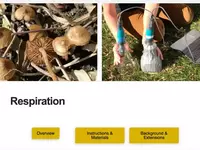https://climate.earthathome.org/respiration/
Alexandra Moore, Paleontological Research Institute
This learning activity takes one 55 minute class period.
Learn more about Teaching Climate Literacy and Energy Awareness»Grade Level
Online Readiness
Topics
Climate Literacy
This Activity builds on the following concepts of Climate Literacy.
Click a topic below for supporting information, teaching ideas, and sample activities.
Energy Literacy
This Activity builds on the following concepts of Energy Literacy.
Click a topic below for supporting information, teaching ideas, and sample activities.
Notes From Our Reviewers
The CLEAN collection is hand-picked and rigorously reviewed for scientific accuracy and classroom effectiveness.
Read what our review team had to say about this resource below or learn more about
how CLEAN reviews teaching materials
Teaching Tips | Science | Pedagogy |
Technical Details
Teaching Tips
- The webpage includes embedded videos and classroom-ready materials. The activity would fit well in several points within a curriculum. Teachers can modify the activity to match student math skills as needed.
- The materials needed to perform the activity are easily accessible with the exception of the required CO2 probe.
About the Content
- Students set-up and collect CO2 flux data, then work with the data they collect. The activity also presents the carbon cycle and mean annual global soil-CO2 emission data.
- Additional data that is presented through the activity is taken from appropriate sources and is of high quality, however, the global data that students make comparisons to at the end of the lesson is of annual global soil CO2 emissions from 1984-1992. Teachers should search for more up-to-date data for students to make comparisons with.
- Passed initial science review - expert science review pending.
About the Pedagogy
- CO2 probes are required to complete this activity unless it is done using the virtual versions of pre-existing data. This limits the impact of the activity, and will be most successful in classrooms where CO2 probes can be utilized.
- In the activity, students follow lab steps to set up and conduct a CO2 flux experiment, record and analyze the data they collect, and then consider their results along with the global carbon cycle. This can be done either inside or outside or fully virtual lab.
- There is little student-guided inquiry, though an educator could easily add this in by asking students to test out different variables that might affect CO2 emissions in the lab environment.
- Students will be engaged in the collection of data and in analyzing the data at various levels depending on their math skills.
- Students can create a data set by making a CO2 respiration flux chamber and analyzing different conditions that could increase/decrease the respiration rate.
- This resource engages students in using scientific data.
See other data-rich activities
Technical Details/Ease of Use
- The activity will have to be completed virtually if students do not have access to lab CO2 probes. The activity is scaffolded allowing students to develop an understanding of each topic "just-in-time" before moving on. Some understanding of basic chemistry is required.
- All materials are PDF which limits the ability of teachers to modify them to meet their classroom needs.
- CO2 flux meters can be tricky to use, so teacher needs to be familiar with these instruments. Lesson is broken down into example videos that allow teacher to follow steps carefully.
- The webpage offers links to complete teacher and student materials including helpful videos demonstrating how teachers can build the required equipment (except the CO2 probe).








